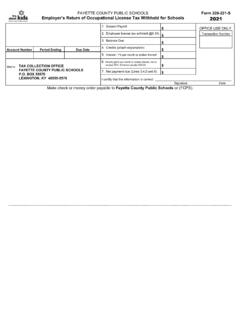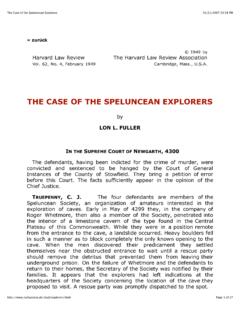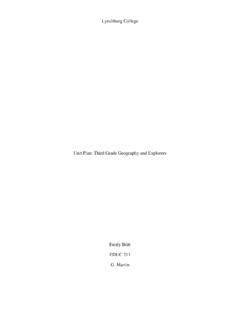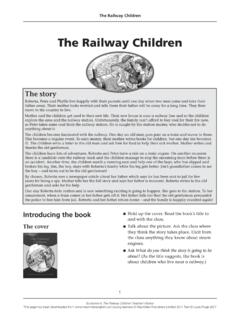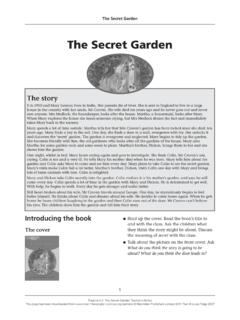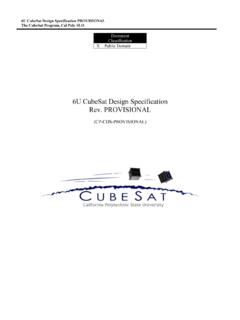Transcription of Activity 1 of 3 for NTI May 18 - 22 - Introduction to ...
1 Activity 1 of 3 for NTI May 18 - 22 - Introduction to Exploration of North America Go to: Click on the link above to read the article. There is a feature at the bottom that will allow you to have the text read to you, if you want. After you read the article, answer the questions below. You can highlight or bold your answers if completing electronically. I have copied the website text below if you need it. The Age of Exploration (also called the Age of Discovery) began in the 1400s and continued through the 1600s. It was a period of time when the European nations began exploring the world. They discovered new routes to India, much of the Far East, and the Americas. The Age of Exploration took place at the same time as the Renaissance.
2 Why explore? Outfitting an expedition could be expensive and risky. Many ships never returned. So why did the Europeans want to explore? The simple answer is money. Although, some individual explorers wanted to gain fame or experience adventure, the main purpose of an expedition was to make money. How did expeditions make money? Expeditions made money primarily by discovering new trade routes for their nations. When the Ottoman Empire captured Constantinople in 1453, many existing trade routes to India and China were shut down. These trade routes were very valuable as they brought in expensive products such as spices and silk. New expeditions tried to discover oceangoing routes to India and the Far East.
3 Some expeditions became rich by discovering gold and silver, such as the expeditions of the Spanish to the Americas. They also found new land where colonies could be established and crops such as sugar, cotton, and tobacco could be grown. Henry the Navigator The Age of Exploration began in the nation of Portugal under the leadership of Henry the Navigator. Henry sent out ships to map and explore the west coast of Africa. They went further south than any previous European expedition and mapped much of western Africa for the Portuguese. In 1488, Portuguese explorer Bartolomeu Dias was the first European to sail around the southern tip of Africa and into the Indian Ocean. Christopher Columbus Soon the Spanish wanted to find a trade route to the Far East.
4 explorer Christopher Columbus thought that he could sail west, across the Atlantic Ocean, to China. He could not get the Portuguese to fund his expedition, so he went to the Spanish. Spanish monarchs Isabella and Ferdinand agreed to pay for Columbus' trip. In 1492 Columbus discovered the New World of the Americas. Portugal and Spain Portugal and Spain became the early leaders in the Age of Exploration. Through the Treaty of Tordesillas the two countries agreed to divide up the New World. Spain got most of the Americas while Portugal got Brazil, India, and Asia. Spain sent over conquistadors to explore the Americas and to conquer the peoples there. Hernan Cortes conquered the Aztec Empire in Mexico and Francisco Pizarro conquered the Inca Empire in Peru.
5 They made Spain rich with the gold and silver they found in the Americas. Portugal sent out Vasco da Gama who found a trade route around the southern tip of Africa and to India. They also explored much of the Far East and were the first Europeans to establish a trading colony in China at Macau. Colonies Other countries such as Great Britain and the Netherlands established colonies in the New World. Eventually Great Britain would surpass all of the European nations in terms of the size of their world wide empire including the thirteen colonies in the Americas that later became the United States. Geography The Age of Exploration was one of the most important times in the history of world geography. A significant portion of the unknown world was mapped during this short period.
6 Also, many advances were made in navigation and mapping which helped future explorers and travelers. Interesting Facts about the Age of Exploration During the Age of Exploration Europeans referred to the entire area of Southeast Asia and India as the "East Indies". The first expedition to circle the globe was led by Portuguese explorer Ferdinand Magellan . Unfortunately, Magellan was killed during the expedition and did not complete the voyage. Some areas of the world were not fully mapped or discovered until well after the Age of Exploration including Eastern Australia , the interior of Africa, the Arctic, and the Antarctic. Many explorers such as Captain James Cook and Sir Francis Drake searched for a Northwest Passage to East Asia, but it wasn't until 1906 that explorer Roald Amundsen completed the journey.
7 1. What were most of the explorers looking for on their expeditions? a. The edge of the Earth b. Giant sea monsters c. New trading routes d. New continents e. The lost city of Atlantis 2. Why did countries fund expensive and risky expeditions? a. To find gold and silver b. To find lands they could colonize c. To find new trading routes to the East Indies d. All of the above e. None of the above 3. The Treaty of Tordesillas divided up the New World between what two countries? a. Spain and Portugal b. England and France c. Germany and Austria d. Italy and Greece e. Spain and France 4. Who was Henry the Navigator? a. The first European to sail around the south of Africa b. The first explorer to discover the Americas c.
8 The conqueror of the Inca Empire in South America d. The first explorer to circumnavigate the world e. The King of Portugal who sent out explorers to map the west coast of Africa 5. Which explorer discovered a trade route around the southern tip of Africa to India? a. Vasco da Gama b. Christopher Columbus c. Hernan Cortes d. Henry the Navigator e. Francisco Pizarro 6. What country sponsored the expedition of Christopher Columbus where he discovered the Americas? a. England b. Spain c. Portugal d. Germany e. Italy 7. Which country founded the thirteen American colonies that later became the United States? a. Spain b. Netherlands c. England d. Portugal e. Germany 8. Which explorer conquered the Aztec Empire in Mexico?
9 A. Christopher Columbus b. Bartolomeu Dias c. Francisco Pizarro d. Hernan Cortes e. Vasco da Gama 9. True or False: The Age of Exploration took place at about the same time as the European Renaissance? a. TRUE b. FALSE 10. What area of the world was still not mapped at the end of the Age of Exploration? a. Much of central Africa b. Arctic and Antarctic c. East Australia d. All of the above e. None of the above Activity 2 of 3 for NTI May 18 - 22 - Explorers Podcast Click on the link above to watch the video. After you watch, answer the questions below. You can highlight or bold your answers if completing electronically. You can read the transcript below of the video. Video transcript: Once upon a time, for thousands of years, the human beings on two continents, Europe and North America, just ignored each other.
10 Then, in the late 980s, a group known as the Norsemen, more famously known as Vikings, left Iceland, heading west. Led by Erik the Red, who had been banished from Iceland for murder, they eventually came across the island of Greenland, and settled there. Later, Erik had a son named Leif Eriksson (get it, Erik SON), who grew up to head even further west, leading a ship to what is today known as Labrador, the Baffin Islands, and Newfoundland. Thus, Eriksson became the first known European to explore North America. Almost 500 years later, Christopher Columbus became the next European to explore the Americas. In 1492 Columbus sailed the ocean blue. Sorry about that. Anyway, after ten weeks at sea, Columbus reached what is now known as the Bahamas.








